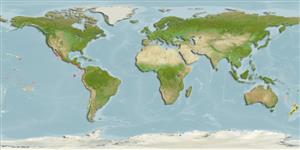>
Pleuronectiformes (Flatfishes) >
Paralichthyidae (Large-tooth flounders)
Etymology: Hippoglossina: Greek, ippos = horse + Greek, glossa = tongue (Ref. 45335).
Eponymy: Charles Harvey Bollman (1868–1889) was an America naturalist principally interested in fish and myriapods, considered by Jordan to be one of the most brilliant and promising naturalists ever known despite being just 20 when he died. [...] (Ref. 128868), visit book page.
More on author: Gilbert.
Environment: milieu / climate zone / depth range / distribution range
Ecología
marino demersal; rango de profundidad 66 - 121 m (Ref. 9330). Tropical; 27°N -
Eastern Pacific: Gulf of California to Peru.
Tamaño / Peso / Age
Maturity: Lm ? range ? - ? cm
Max length : 37.0 cm TL macho / no sexado; (Ref. 130775); common length : 18.0 cm TL macho / no sexado; (Ref. 55763); peso máximo publicado: 481.20 g (Ref. 130775)
Inhabits soft or rocky bottoms. Exploited on a local level with trawl nets and is utilized fresh or as fishmeal.
Life cycle and mating behavior
Madurez | Reproducción | Puesta | Huevos | Fecundidad | Larva
Distinct pairing (Ref. 205).
Hensley, D.A., 1995. Paralichthyidae. Lenguados. p. 1349-1380. In W. Fischer, F. Krupp, W. Schneider, C. Sommer, K.E. Carpenter and V. Niem (eds.) Guia FAO para Identification de Especies para lo Fines de la Pesca. Pacifico Centro-Oriental. 3 Vols. FAO, Rome. (Ref. 9330)
IUCN Red List Status (Ref. 130435: Version 2024-2)
Threat to humans
Harmless
Human uses
Pesquerías: escaso valor comercial
Herramientas
Special reports
Download XML
Fuentes de Internet
Estimates based on models
Preferred temperature (Ref.
123201): 13.4 - 18.1, mean 15.9 °C (based on 18 cells).
Phylogenetic diversity index (Ref.
82804): PD
50 = 0.5078 [Uniqueness, from 0.5 = low to 2.0 = high].
Bayesian length-weight: a=0.00724 (0.00347 - 0.01512), b=3.17 (3.00 - 3.34), in cm total length, based on LWR estimates for this (Sub)family-body shape (Ref.
93245).
Nivel trófico (Ref.
69278): 3.9 ±0.2 se; based on size and trophs of closest relatives
Resiliencia (Ref.
120179): Alto, población duplicada en un tiempo mínimo inferior a 15 meses (Preliminary K or Fecundity.).
Fishing Vulnerability (Ref.
59153): Low to moderate vulnerability (27 of 100).
